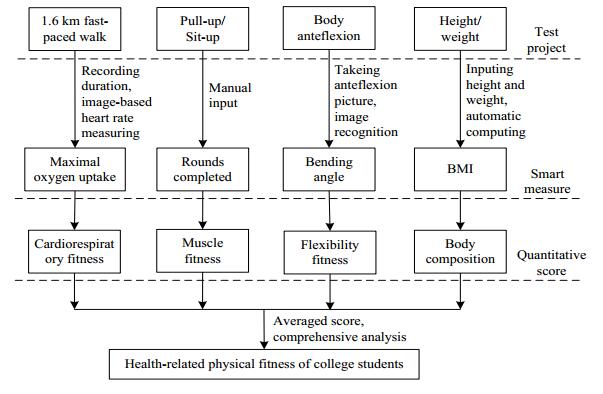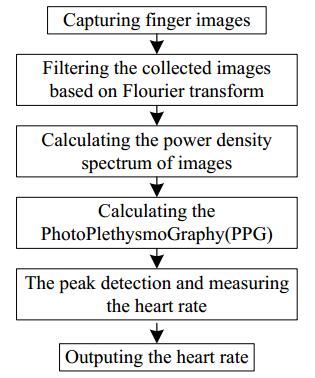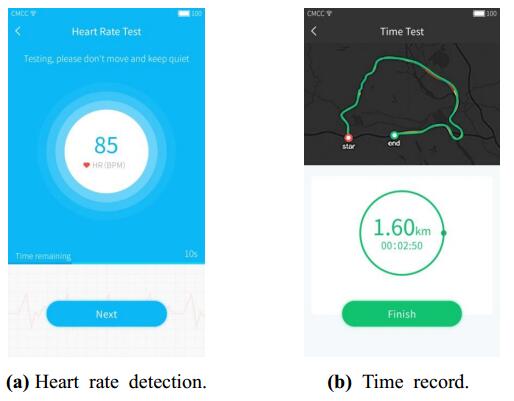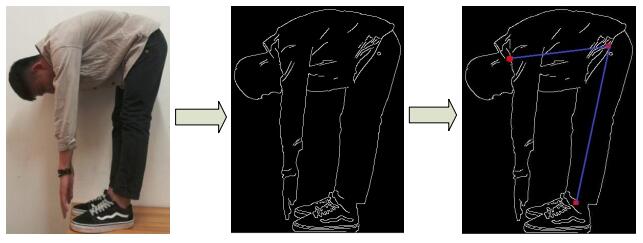Improving health-related physical fitness plays an important role in enhancing the comprehensive physical fitness of college students. The traditional test of health-related physical fitness is characterized by complicated operations and low efficiency. A set of test methods for health-related physical fitness of college students based on an intelligent mobile terminal is designed in this work. The intelligent test method calculates the health-related physical fitness level of users through image acquisition and analysis by combining intelligent terminal software and test items of key elements. To verify the validity of the proposed method, a total of 116 college students (59 males and 57 females) aged between 18 and 22 are chosen as test respondents. The health-related physical fitness of respondents is tested and compared by using the traditional and proposed methods. The traditional test method reports the cardiorespiratory fitness scores of 69.6 ± 9.5 (M) and 77.1 ± 9.9 (F), and the proposed method reports 70.9 ± 9.7 (M) and 77.7 ± 9.8 (F). Twenty samples are chosen randomly to calculate the correlation coefficients r = 0.944 (M) and 0.965 (F) and significance p = 0.145 (M) and 0.489 (F). The flexibility fitness scores in the traditional method are 74.6 ± 11.9 (M) and 73.3 ± 11.5 (F), and the scores of the proposed method are 74.8 ± 11.5 (M) and 75.0 ± 11.2 (F). Twenty samples are chosen randomly to calculate r = 0.944 (M) and 0.938 (F) and p = 0.941 (M) and 0.098 (F). In the proposed method, muscle strength/muscular endurance fitness and a body composition module are tested by the traditional method, and test data are input into an artificial input system. The experimental results verify the accuracy of the proposed method in evaluating the health-related physical fitness of college students. Application of the proposed method can effectively reduce the cost of physical fitness testing, increase the convenience of testing, and direct substantial attention to the health-related physical fitness of college students.
1.
Introduction
Physical fitness is interpreted as a measure of the ability to perform physical activity that integrates the majority of bodily functions, and its components are divided into those related to health and those related to athletic skill [1]. Common people are mainly concerned about physical fitness, which is needed to promote health conditions, prevent diseases, and improve daily life and work efficiency. This fitness is physical-related physical fitness [2,3]. Physical-related physical fitness is composed of five basic elements: cardiorespiratory fitness, muscle fitness, muscular endurance fitness, flexibility fitness, and body composition [4,5]. Chinese college students generally have many physical problems, such as muscle weakness and being overweight [6]. Some declining physical indexes of college students are highly consistent with the five basic elements of health-related physical fitness. For example, improving cardiorespiratory fitness is conducive to enhancing the pulmonary function of college students. Improving muscle fitness and muscular endurance and flexibility fitness is beneficial to enhancing endurance, strength, speed, and other physical indexes of college students. Optimization of body composition is beneficial to reducing the weight of obese college students. Thus, improving the health-related physical fitness of college students can effectively improve their physical conditions.
Most countries have formulated relevant physical test methods for students [7,8,9]. The traditional test method of the health-related physical fitness of college students, which is accomplished with human assistance, is the most common test method at present. To improve the level and statistical efficiency of the testing of the health-related physical fitness of college students, researchers have developed several electronic test devices [10,11,12,13,14]. These devices are generally designed for tests and records of specific items and include the electronic long-distance running tester, electronic pull-up tester, electronic sit-and-reach tester, and electronic sit-up tester. These devices generally consist of detection and record devices. Sensors in detection devices are responsible for measuring items and transmitting data to a recording device through wired or wireless communication means. These instruments generally have large volume, high cost, diversified categories, complicated installation and arrangement, and inconvenient applications. Therefore, developing a simple and flexible testing technology for the health-related physical fitness of college students is necessary to reduce detection cost and simplify detection operations.
Currently, mobile Internet and intelligent mobile terminals are developed quickly and widely used in various aspects of production and daily living, thereby changing the lifestyles of people [15,16]. These technologies provide new ideas for the intelligent testing of health-related physical fitness. Computer-supported systems or tools have been increasingly emerging in intelligent mobile terminals [17]; most of them target college students and youth. Such systems and applications include Fitness Tour [18], StepSteam [19], and tools proposed by Buttussi et al. [20] and Cai et al. [21]. Fitness Tour is an Android-based mobile application in the healthcare domain that aims to promote physical activity by randomly generating exercise tours. StepSteam is a computer-supported system for improving the attitudes of students toward fitness and increasing their sense of social support for fitness. Buttussi et al. designed a mobile phone application that dynamically presents virtual monsters, gold, and other items corresponding to such factors as users' heart rate, age, and exercise phase to encourage users to speed up or slow down. Cai et al. presented the foundation of a design framework used to integrate game elements to an application with location-based services for smartphones.
The above test methods for health-related physical fitness based on intelligent mobile terminals are mainly used in game application programs to increase the interest of youths in health testing and exercise training. These systems often lack scientificity and stringency and are inapplicable to the official and formal testing of the health-related physical fitness of college students. In this study, image pattern recognition and artificial intelligence technology are combined with evaluation standards of health-related physical fitness to explore an intelligent scientific test method for health-related physical fitness.
2.
Proposed method
An intelligent comprehensive test system for the health-related physical fitness of college students based on intelligent mobile terminals (smartphones) is designed. Users can determine their health-related physical fitness levels by using their smartphones and performing standard test operations. A quantitative test result is relayed to users by the comprehensive analysis of an intelligent software in their smartphones. Thus, individuals can have an intuitive knowledge of their health-related physical fitness level. The system also provides exercise suggestions and methods to improve health-related physical fitness according to specific indexes of users. The test process of the proposed method is shown in Figure 1.
The proposed method divides the health-related physical fitness of college students into four modules (muscle fitness and muscular endurance fitness are integrated.), namely, cardiorespiratory fitness, muscle/muscular endurance fitness, flexibility fitness, and body composition. In the following subsections, the test methods of the different modules are elaborated.
2.1. Cardiorespiratory fitness test
The 1.6 km fast-paced walk, a common cardiorespiratory fitness test item [22], is chosen as the cardiorespiratory fitness test item of college students in this system. Maximum oxygen uptake (VO2max) is chosen as the major test index [23], which can be calculated according to the following equations: VO2max = 132.853 − (0.1695 × body weight) − (0.3877 × age) + (6.3150 × gender) − (3.2649 × time length) − (0.1565 × heart rate) [24]. The unit of body weight is kg, and the unit of age is years. The gender values are male = 1 and female = 0. The time length unit is min, and the heart unit is bpm. The unit of VO2max is ml/kg/min. Time length is the time needed to finish the 1.6 km fast-paced walk, which can be automatically timed and recorded into the system by phones. Heart rate is the heart rate tested at the first time after arriving at the destination of the 1.6 km fast-paced walk. This system measures heart rate by image processing of smartphones and without the assistance of other tools. Every heartbeat of the human body will make a waveform flow of blood in the blood capillary of a fingertip. At hyperemia of the blood capillary, the oxygen content in blood increases, and blood appears bright red. After the oxygen in blood is consumed, the blood becomes dark red. Thus, fingertip color changes are recorded by smartphones to detect the change period of colors. Then, the heartbeat period, that is, the heart rate, can be calculated [25,26]. In this system, a user places a fingertip at the camera of a smartphone and turns the flash lamp on to enhance the imaging effect. Image sensors in the phone camera are used to take pictures of blood color changes in the fingertip of the user. Heart rate is calculated after the detected image signals are denoised. The process of finger image analysis is shown in Figure 2.
The interfaces of heart detection and time-length record functions in this system are shown in Figures 3(a) and 3(b).
2.2. Muscle/Muscular endurance fitness test
In this system, pull-up and sit-up are chosen as the test items for the muscle/muscular endurance fitness of male and female students, respectively. The number of pull-ups or sit-ups is used as the test index. The higher the number, the better the muscle/muscular endurance fitness. Users can accomplish some detection by manual counting and inputting data into smartphones.
2.3. Flexibility fitness test
This system uses the body anteflexion (sit-and-reach or stand-trunk-bending) as the test program for the flexibility fitness measurement of college students. Using smartphones, it directly measures the bending angle of users through image recognition to observe the flexibility fitness level. The specific process is as follows. Sitting or stand-trunk-bending images of users are captured by others or through a mirror from the side by phone cameras. The images are analyzed and processed by the system. Images are processed by calibration, marginal extraction, and feature point selection. The bending angle of users is calculated. The image acquisition and analysis processes are shown in Figure 4 The study participant in the figure is one of the researchers of this work, and he agreed to publish the images.
The following procedure is used for bending image recognition.
(1) Image preprocessing. The image is converted to grayscale.
(2) The edge of the human body is detected by an improved edge detector. The bilateral filter is used to filter an image to preserve its edge information, and then, a 3*3 template is used to calculate the gradient amplitude and direction of the image.
(3) Three feature points needed by the algorithm are extracted, and their coordinates are obtained from the image.
(4) The angle of the points is computed, and the result is outputted.
2.4. Body composition test
The body mass index (BMI) is used as the test index of the body composition of college students in the system. BMI, the proportion of weight to square of height (weight/square of height), is an important parameter that represents the composition of the human body [27]. Therefore, the BMI of users can be calculated by smartphones after the weight and height are entered into the system, and the body composition level is consequently reflected.
2.5. Scoring method of the system
Different algorithms are designed in the system to score the results of detection items. With reference to national standards, relevant data and measurement experiment, the calculation formulas of the quantitative scores of the different modules are listed in Table 1.
The four modules are scored from 0 to 100, where 0 is the lowest, and 100 is the highest. Results are used as the user scores in the corresponding modules. The total points of the health-related physical fitness of users are the mean of scores of the four modules. Based on the abovementioned method, the system will detect the health-related physical fitness level of users. Furthermore, specific exercise suggestions and methods are given according to the scores of each module.
3.
Results
To verify the validity of the proposed method, a total of 116 undergraduates from Guangdong Polytechnic Normal University in China are chosen for the test. The correlation between the traditional artificial test results and results of the proposed method is compared. The experiments are carried out under the consent of Guangdong Polytechnic Normal University and in accordance with national regulations, and informed consent is obtained from all subjects. These undergraduates come from three majors, namely, automation (42), education (38), and music performance (36), with 59 males and 57 females aged between 18 and 22 (average 20.3 years old) included. A general description of the test respondents is shown in Table 2.
In terms of the proposed method, the muscle/muscular endurance fitness module and body composition module manually input test data into the intelligent terminals and hence do not involve the intelligent test technology. Therefore, the data of these modules are deemed consistent with those of the traditional method without the need for experimental comparison and verification. In this study, only the cardiorespiratory fitness and muscle/muscular endurance fitness modules are verified by experiments. In the experiment of the cardiorespiratory fitness module, the test results of 1000 (M)/800 (F) m run are compared with test results of the proposed method. In the flexibility fitness experiment, results of the traditional sit-and-reach test are compared with those of the proposed method. All experiments have reasonable intervals in the middle process and will not influence the physical or body performances of the respondents as well as the mutual influences of the different test items.
3.1. Test results of cardiorespiratory fitness
The cardiorespiratory fitness scores of the 116 college students, which are obtained from the traditional 1000 (M)/800 (F) m run and the 1.6 km fast-paced walk in the proposed method, are listed in Table 3.
Test data of 10 males and 10 females are chosen randomly (Table 4).
3.2. Test results of flexibility fitness
The flexibility fitness scores of the 116 college students that are measured by the traditional method and the proposed method in the experiment are listed in Table 5.
Test data of 10 males and 10 females are chosen randomly (Table 6).
4.
Discussion
4.1. Cardiorespiratory fitness experiment
In the cardiorespiratory fitness experiment, the quiet heart rate test, 3 min stepping test, 1.6 km fast-paced walk, and 12 m run are the test items that are appropriate for common college students [28,29]. Each of these test items has its own advantages and disadvantages. The quiet heart rate test is easy to operate, but it cannot completely and accurately reflect the cardiorespiratory fitness level. The 3 min stepping test has low requirements on fields, but it has high requirements on action standards of test objects. According to studies and practices, it is inapplicable to be used extensively to college students in China [30]. The 12 min run is a method of indirectly deducing the maximum oxygen uptake, and it has been used extensively in many countries. The time length of 12 min is a challenge to college students, and some students cannot accomplish it well. Therefore, the test results cannot meet the needs of our study. In this work, the 1.6 km fast-paced walk is chosen as the test item, and the maximum oxygen uptake is calculated according to the test results to evaluate the cardiorespiratory fitness level.
The 20 samples in Table 4 show that the cardiorespiratory fitness scores of the college students in the proposed system are close to those in the traditional method. The average difference is small (3.3 in males and 2.2 in females). To further verify the correlation between the data of the proposed and traditional methods and determine whether the data difference between the two methods has statistical significance, the test data are analyzed by SPSS. Bivariate correlation analysis is firstly conducted, and the Pearson's correlation coefficient is obtained. Two groups of data are matched for a T-test of the samples. The confidence level (%) is set at 95%, and the two-tailed significance is calculated. Results are shown in Table 7.
Table 7 demonstrates that values of two r are relatively large, indicating a strong correlation between the two groups. The p values are higher than 0.05, implying no statistical significance of the difference between the two groups. Thus, the cardiorespiratory fitness test module in the proposed method is scientific and accurate.
4.2. Flexibility fitness experiment
Currently, flexibility fitness is mainly tested by mechanical sit-and-reach testers. The maximum stretching distance of fingers is used as the evaluation index. This test method, which replaces the joint motion angle by the stretching distance of fingers, has a considerable shortcoming because different arm lengths will influence the stretching distances of fingers, thereby increasing measurement error and reducing detection validity. Based on the correlation of body anteflexion with upper limbs, lower limbs, body, and angle, several researchers have identified certain unreasonable factors of the sit-and-reach and stand-trunk-bending test methods [31,32,33]. If the moving angles of body joints can be measured, the effects of limb length on measurement validity can be overcome. The image recognition technology used in the proposed method directly detects the bending angle of the human body. This innovation of flexibility fitness testing presents a certain advancement.
Table 6 shows that the flexibility fitness scores of the proposed method are close to those of the traditional method. The mean difference is small (3.4 for males and 4.1 for females). Test results of the traditional sit-and-reach tester are sensitive to the limb length of the test objects, and the test results are not completely accurate. However, as the standard physical fitness test item of students in many countries, it is still authoritative. In this work, correlation and difference between the data of the two methods are tested by SPSS. First, bivariate correlation is analyzed, and Pearson's coefficient is calculated. The two groups of data are matched for a T-test of the samples. The confidence level (%) is set at 95% and two-tailed significance is calculated. Results are listed in Table 8.
Table 8 illustrates that the r values are relatively large, indicating a strong correlation between the data of the two methods. The difference between the two groups of data is not statistically significant, as the two p values are higher than 0.05. Therefore, the flexibility fitness module in the proposed system is scientific and accurate.
5.
Conclusion
The current situations regarding the evaluation standards and testing technologies of health-related physical fitness are analyzed. The significance of mobile Internet in health-related physical fitness is discussed. A test method of the health-related physical fitness of college students that is based on mobile Internet is designed. In this method, the camera of a mobile phone is used to capture the finger and bending images of users, and the calculation function of the mobile phone is used to obtain the measurements of the users' heart rate, flexibility, and other parameters. Then, we can determine the cardiorespiratory fitness, muscle fitness, muscular endurance fitness, flexibility fitness, and body composition of the users. Experimental results demonstrate that the proposed method can accurately test the health-related physical fitness of college students. The test data have a strong correlation with authoritative traditional data, and no statistically significant difference between the two methods is observed. The proposed system can change the current situations characterized by heavy dependence on complicated professional instruments and current data management depending on artificial records and inputs. It also effectively improves the management efficiency of the physical fitness testing of college students. Moreover, this method can encourage college students to participate in health-related physical fitness testing and help them determine their health-related physical fitness level at any time by using smartphones. Eventually, this technology can stimulate the enthusiasm of college students toward sports exercises and improve their physical health.
Acknowledgments
This work is supported in part by the National Natural Science Foundation of China (61802073), the Key Scientific and Technological Planning Project of Guangzhou, China (201704020113), and the Scientific and Technological Project of Guangdong Province, China (2017A040405059).
Conflict of Interest
The authors declare no conflict of interest in this paper.










 DownLoad:
DownLoad:





